Employee Rewards Impact on Productivity: Dissertation
VerifiedAdded on 2020/05/28
|54
|13619
|112
Thesis and Dissertation
AI Summary
This dissertation investigates the impact of employee rewards on productivity within Baxter Healthcare Ltd. It explores the research problem of employee retention and the importance of reward structures in motivating employees. The study includes an introduction outlining research objectives, questions, and the dissertation's structure. A literature review analyzes existing research on rewards and productivity, including relevant theories like Maslow's and Herzberg's. The methodology chapter details the research strategy, data collection, and analysis methods. The data analysis and findings chapter presents the results, followed by a conclusion and recommendations. The research aims to understand the meaning of rewards, their impact on employee performance, and suggest ways to improve productivity through reward systems. The research is crucial for understanding the relationship between employee rewards and employee productivity, offering insights into retaining employees and enhancing business growth.
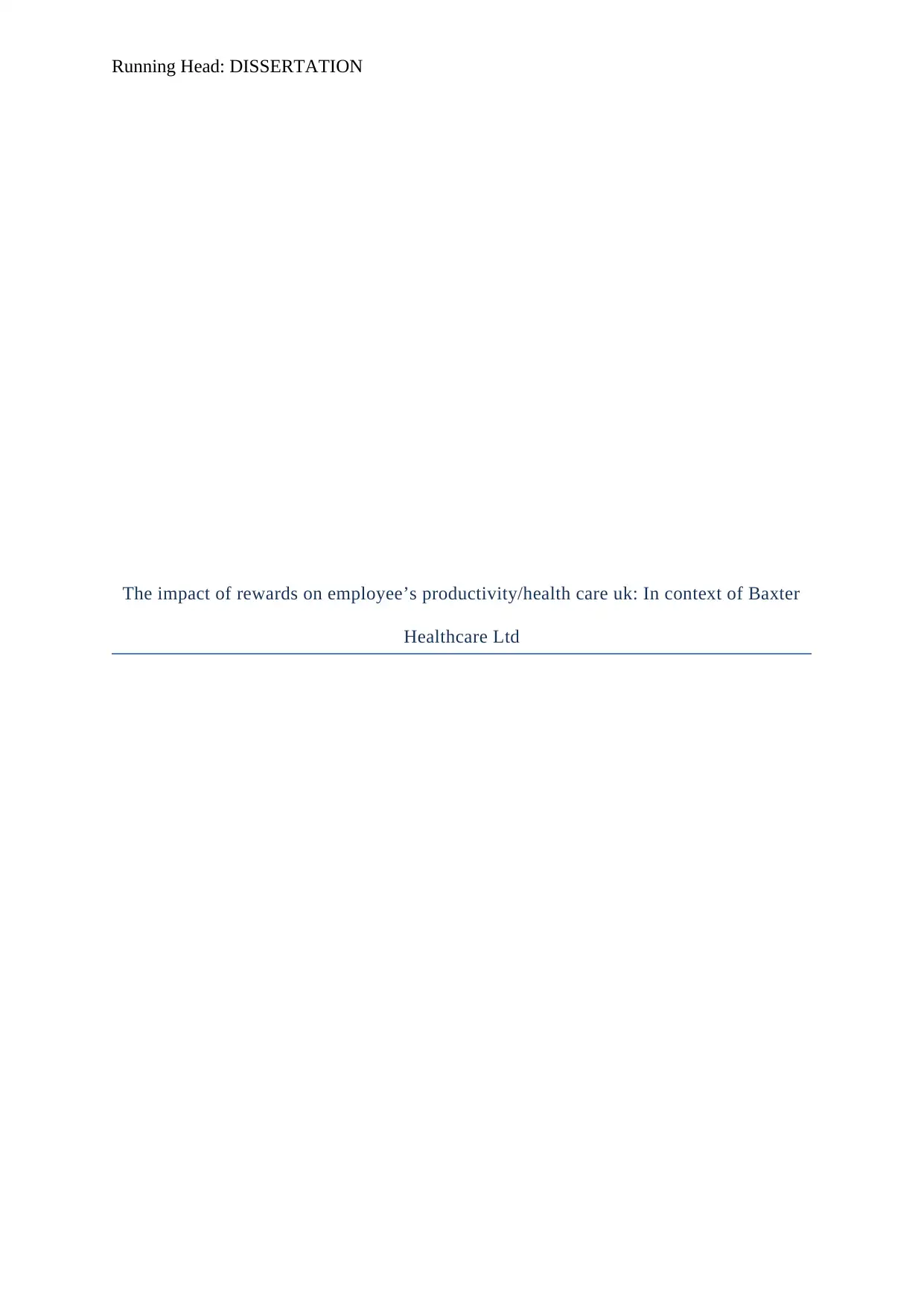
Running Head: DISSERTATION
The impact of rewards on employee’s productivity/health care uk: In context of Baxter
Healthcare Ltd
The impact of rewards on employee’s productivity/health care uk: In context of Baxter
Healthcare Ltd
Paraphrase This Document
Need a fresh take? Get an instant paraphrase of this document with our AI Paraphraser
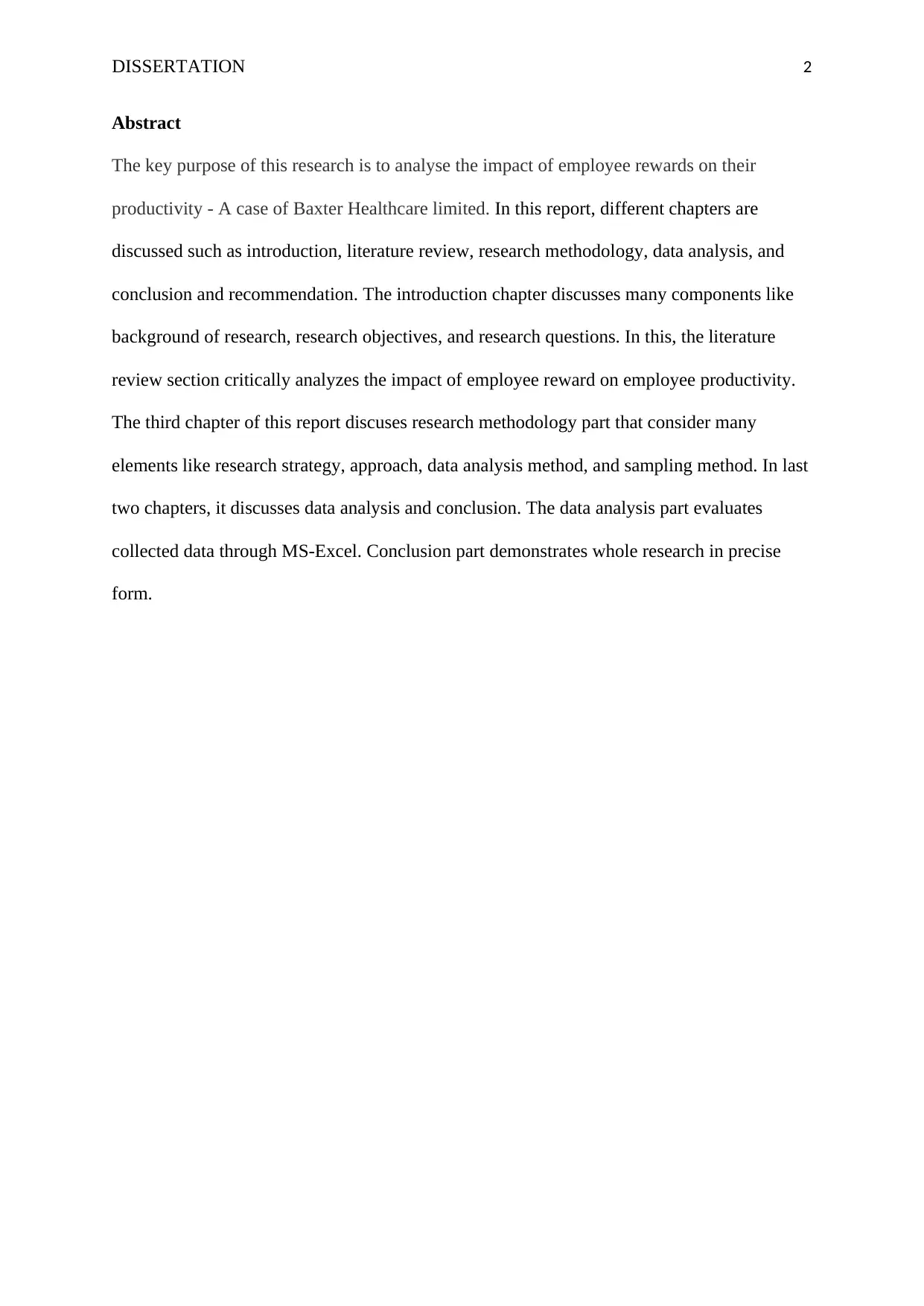
DISSERTATION 2
Abstract
The key purpose of this research is to analyse the impact of employee rewards on their
productivity - A case of Baxter Healthcare limited. In this report, different chapters are
discussed such as introduction, literature review, research methodology, data analysis, and
conclusion and recommendation. The introduction chapter discusses many components like
background of research, research objectives, and research questions. In this, the literature
review section critically analyzes the impact of employee reward on employee productivity.
The third chapter of this report discuses research methodology part that consider many
elements like research strategy, approach, data analysis method, and sampling method. In last
two chapters, it discusses data analysis and conclusion. The data analysis part evaluates
collected data through MS-Excel. Conclusion part demonstrates whole research in precise
form.
Abstract
The key purpose of this research is to analyse the impact of employee rewards on their
productivity - A case of Baxter Healthcare limited. In this report, different chapters are
discussed such as introduction, literature review, research methodology, data analysis, and
conclusion and recommendation. The introduction chapter discusses many components like
background of research, research objectives, and research questions. In this, the literature
review section critically analyzes the impact of employee reward on employee productivity.
The third chapter of this report discuses research methodology part that consider many
elements like research strategy, approach, data analysis method, and sampling method. In last
two chapters, it discusses data analysis and conclusion. The data analysis part evaluates
collected data through MS-Excel. Conclusion part demonstrates whole research in precise
form.
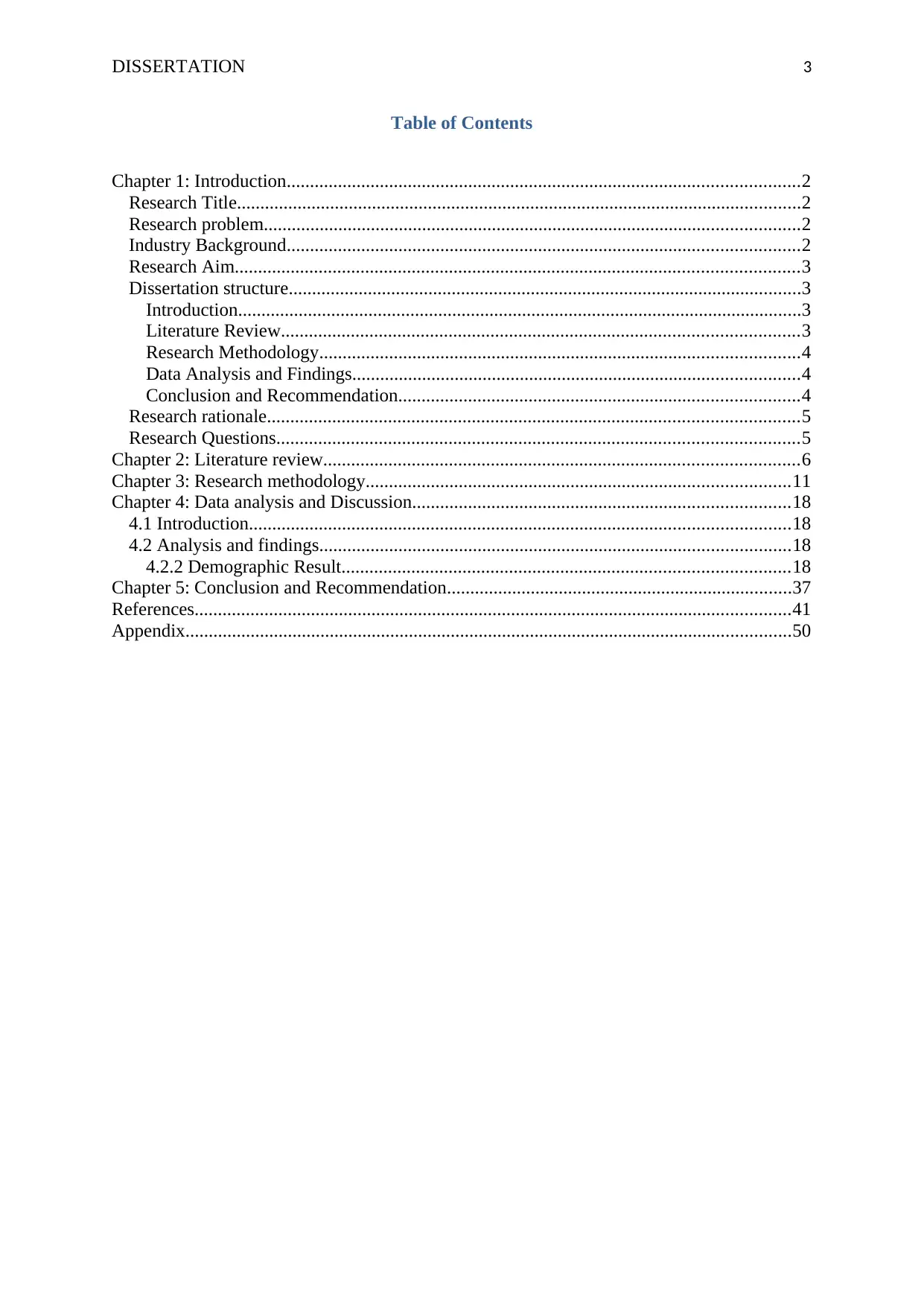
DISSERTATION 3
Table of Contents
Chapter 1: Introduction..............................................................................................................2
Research Title.........................................................................................................................2
Research problem...................................................................................................................2
Industry Background..............................................................................................................2
Research Aim.........................................................................................................................3
Dissertation structure..............................................................................................................3
Introduction.........................................................................................................................3
Literature Review...............................................................................................................3
Research Methodology.......................................................................................................4
Data Analysis and Findings................................................................................................4
Conclusion and Recommendation......................................................................................4
Research rationale..................................................................................................................5
Research Questions................................................................................................................5
Chapter 2: Literature review......................................................................................................6
Chapter 3: Research methodology...........................................................................................11
Chapter 4: Data analysis and Discussion.................................................................................18
4.1 Introduction....................................................................................................................18
4.2 Analysis and findings.....................................................................................................18
4.2.2 Demographic Result................................................................................................18
Chapter 5: Conclusion and Recommendation..........................................................................37
References................................................................................................................................41
Appendix..................................................................................................................................50
Table of Contents
Chapter 1: Introduction..............................................................................................................2
Research Title.........................................................................................................................2
Research problem...................................................................................................................2
Industry Background..............................................................................................................2
Research Aim.........................................................................................................................3
Dissertation structure..............................................................................................................3
Introduction.........................................................................................................................3
Literature Review...............................................................................................................3
Research Methodology.......................................................................................................4
Data Analysis and Findings................................................................................................4
Conclusion and Recommendation......................................................................................4
Research rationale..................................................................................................................5
Research Questions................................................................................................................5
Chapter 2: Literature review......................................................................................................6
Chapter 3: Research methodology...........................................................................................11
Chapter 4: Data analysis and Discussion.................................................................................18
4.1 Introduction....................................................................................................................18
4.2 Analysis and findings.....................................................................................................18
4.2.2 Demographic Result................................................................................................18
Chapter 5: Conclusion and Recommendation..........................................................................37
References................................................................................................................................41
Appendix..................................................................................................................................50
⊘ This is a preview!⊘
Do you want full access?
Subscribe today to unlock all pages.

Trusted by 1+ million students worldwide
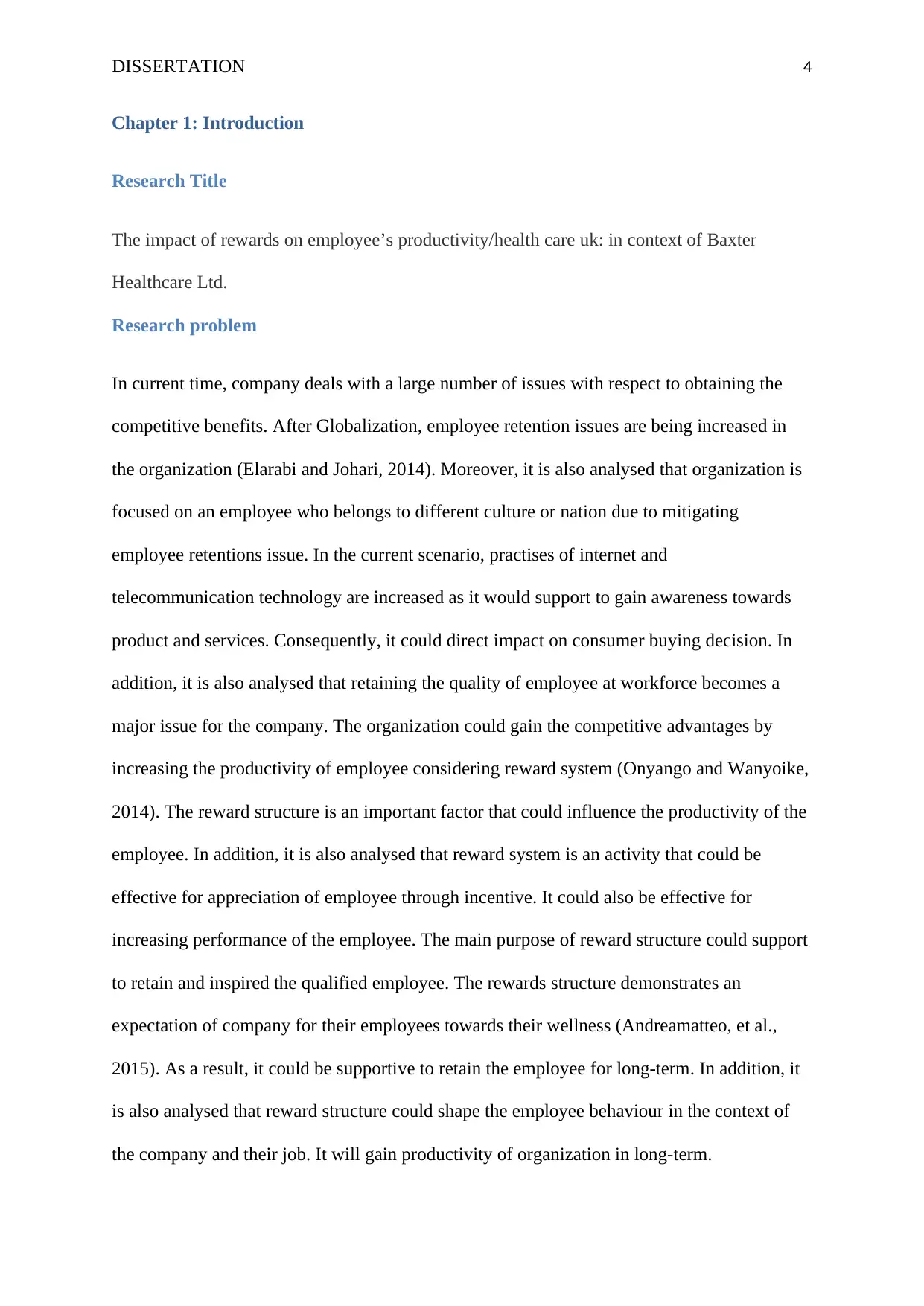
DISSERTATION 4
Chapter 1: Introduction
Research Title
The impact of rewards on employee’s productivity/health care uk: in context of Baxter
Healthcare Ltd.
Research problem
In current time, company deals with a large number of issues with respect to obtaining the
competitive benefits. After Globalization, employee retention issues are being increased in
the organization (Elarabi and Johari, 2014). Moreover, it is also analysed that organization is
focused on an employee who belongs to different culture or nation due to mitigating
employee retentions issue. In the current scenario, practises of internet and
telecommunication technology are increased as it would support to gain awareness towards
product and services. Consequently, it could direct impact on consumer buying decision. In
addition, it is also analysed that retaining the quality of employee at workforce becomes a
major issue for the company. The organization could gain the competitive advantages by
increasing the productivity of employee considering reward system (Onyango and Wanyoike,
2014). The reward structure is an important factor that could influence the productivity of the
employee. In addition, it is also analysed that reward system is an activity that could be
effective for appreciation of employee through incentive. It could also be effective for
increasing performance of the employee. The main purpose of reward structure could support
to retain and inspired the qualified employee. The rewards structure demonstrates an
expectation of company for their employees towards their wellness (Andreamatteo, et al.,
2015). As a result, it could be supportive to retain the employee for long-term. In addition, it
is also analysed that reward structure could shape the employee behaviour in the context of
the company and their job. It will gain productivity of organization in long-term.
Chapter 1: Introduction
Research Title
The impact of rewards on employee’s productivity/health care uk: in context of Baxter
Healthcare Ltd.
Research problem
In current time, company deals with a large number of issues with respect to obtaining the
competitive benefits. After Globalization, employee retention issues are being increased in
the organization (Elarabi and Johari, 2014). Moreover, it is also analysed that organization is
focused on an employee who belongs to different culture or nation due to mitigating
employee retentions issue. In the current scenario, practises of internet and
telecommunication technology are increased as it would support to gain awareness towards
product and services. Consequently, it could direct impact on consumer buying decision. In
addition, it is also analysed that retaining the quality of employee at workforce becomes a
major issue for the company. The organization could gain the competitive advantages by
increasing the productivity of employee considering reward system (Onyango and Wanyoike,
2014). The reward structure is an important factor that could influence the productivity of the
employee. In addition, it is also analysed that reward system is an activity that could be
effective for appreciation of employee through incentive. It could also be effective for
increasing performance of the employee. The main purpose of reward structure could support
to retain and inspired the qualified employee. The rewards structure demonstrates an
expectation of company for their employees towards their wellness (Andreamatteo, et al.,
2015). As a result, it could be supportive to retain the employee for long-term. In addition, it
is also analysed that reward structure could shape the employee behaviour in the context of
the company and their job. It will gain productivity of organization in long-term.
Paraphrase This Document
Need a fresh take? Get an instant paraphrase of this document with our AI Paraphraser
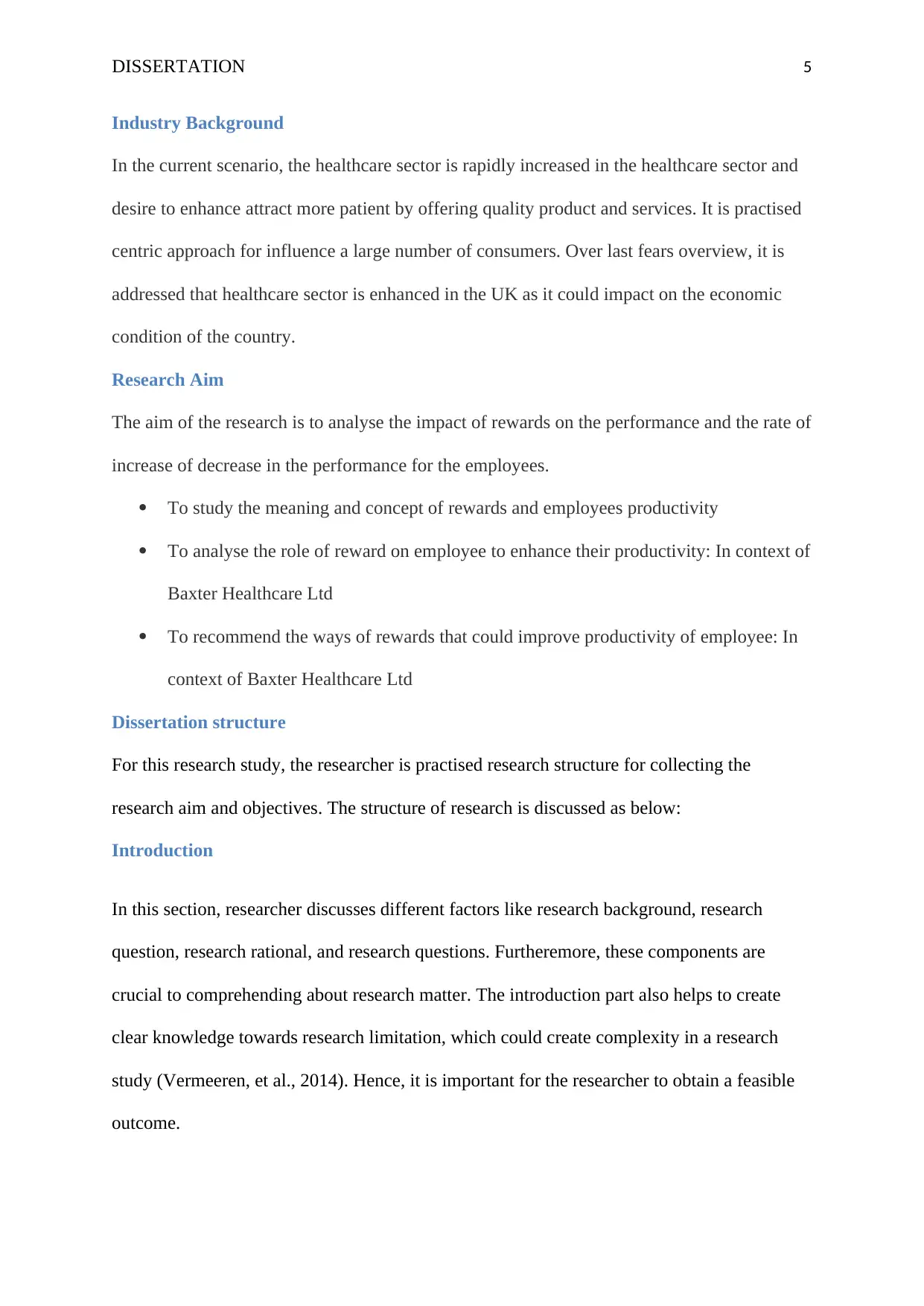
DISSERTATION 5
Industry Background
In the current scenario, the healthcare sector is rapidly increased in the healthcare sector and
desire to enhance attract more patient by offering quality product and services. It is practised
centric approach for influence a large number of consumers. Over last fears overview, it is
addressed that healthcare sector is enhanced in the UK as it could impact on the economic
condition of the country.
Research Aim
The aim of the research is to analyse the impact of rewards on the performance and the rate of
increase of decrease in the performance for the employees.
To study the meaning and concept of rewards and employees productivity
To analyse the role of reward on employee to enhance their productivity: In context of
Baxter Healthcare Ltd
To recommend the ways of rewards that could improve productivity of employee: In
context of Baxter Healthcare Ltd
Dissertation structure
For this research study, the researcher is practised research structure for collecting the
research aim and objectives. The structure of research is discussed as below:
Introduction
In this section, researcher discusses different factors like research background, research
question, research rational, and research questions. Furtheremore, these components are
crucial to comprehending about research matter. The introduction part also helps to create
clear knowledge towards research limitation, which could create complexity in a research
study (Vermeeren, et al., 2014). Hence, it is important for the researcher to obtain a feasible
outcome.
Industry Background
In the current scenario, the healthcare sector is rapidly increased in the healthcare sector and
desire to enhance attract more patient by offering quality product and services. It is practised
centric approach for influence a large number of consumers. Over last fears overview, it is
addressed that healthcare sector is enhanced in the UK as it could impact on the economic
condition of the country.
Research Aim
The aim of the research is to analyse the impact of rewards on the performance and the rate of
increase of decrease in the performance for the employees.
To study the meaning and concept of rewards and employees productivity
To analyse the role of reward on employee to enhance their productivity: In context of
Baxter Healthcare Ltd
To recommend the ways of rewards that could improve productivity of employee: In
context of Baxter Healthcare Ltd
Dissertation structure
For this research study, the researcher is practised research structure for collecting the
research aim and objectives. The structure of research is discussed as below:
Introduction
In this section, researcher discusses different factors like research background, research
question, research rational, and research questions. Furtheremore, these components are
crucial to comprehending about research matter. The introduction part also helps to create
clear knowledge towards research limitation, which could create complexity in a research
study (Vermeeren, et al., 2014). Hence, it is important for the researcher to obtain a feasible
outcome.
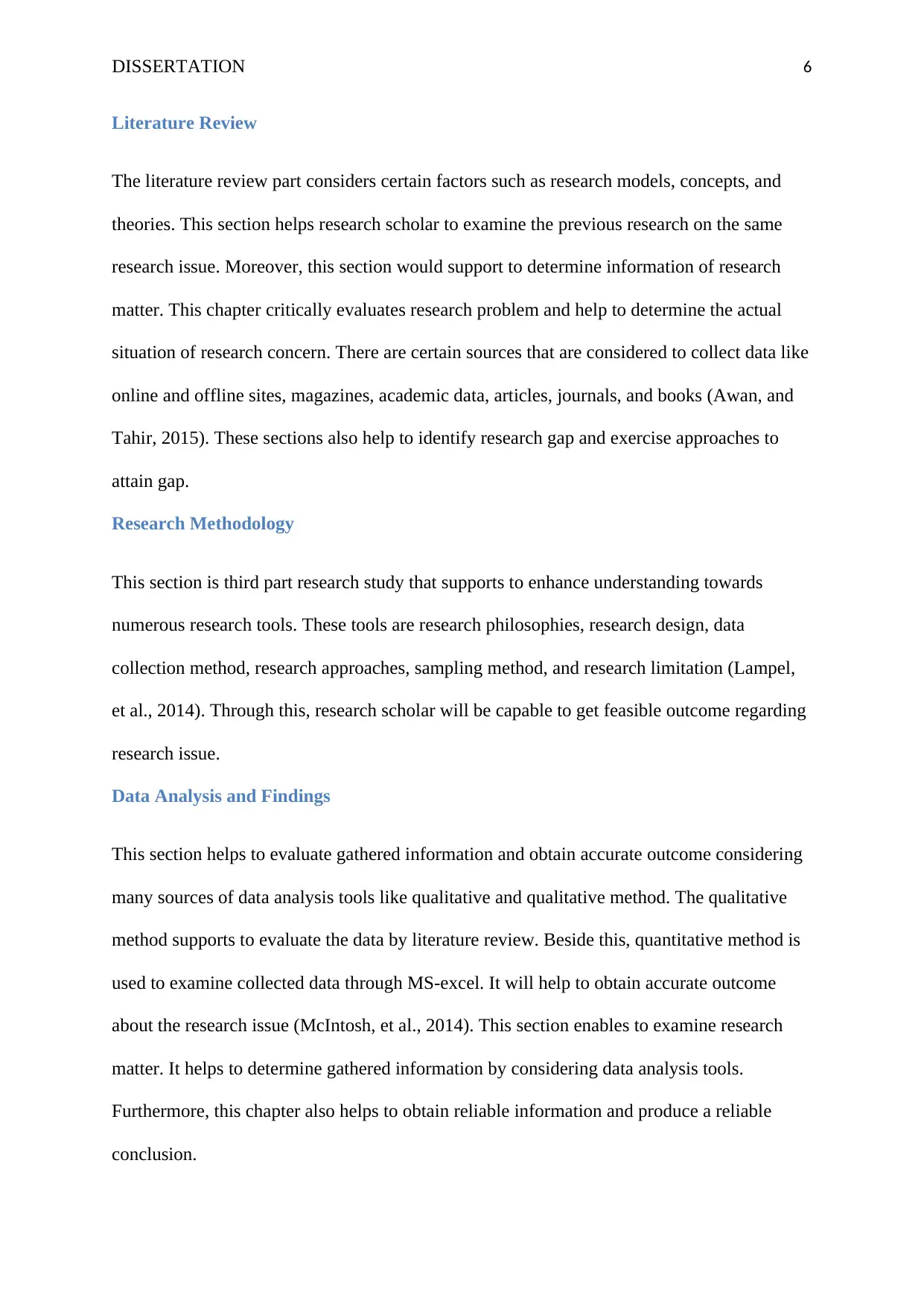
DISSERTATION 6
Literature Review
The literature review part considers certain factors such as research models, concepts, and
theories. This section helps research scholar to examine the previous research on the same
research issue. Moreover, this section would support to determine information of research
matter. This chapter critically evaluates research problem and help to determine the actual
situation of research concern. There are certain sources that are considered to collect data like
online and offline sites, magazines, academic data, articles, journals, and books (Awan, and
Tahir, 2015). These sections also help to identify research gap and exercise approaches to
attain gap.
Research Methodology
This section is third part research study that supports to enhance understanding towards
numerous research tools. These tools are research philosophies, research design, data
collection method, research approaches, sampling method, and research limitation (Lampel,
et al., 2014). Through this, research scholar will be capable to get feasible outcome regarding
research issue.
Data Analysis and Findings
This section helps to evaluate gathered information and obtain accurate outcome considering
many sources of data analysis tools like qualitative and qualitative method. The qualitative
method supports to evaluate the data by literature review. Beside this, quantitative method is
used to examine collected data through MS-excel. It will help to obtain accurate outcome
about the research issue (McIntosh, et al., 2014). This section enables to examine research
matter. It helps to determine gathered information by considering data analysis tools.
Furthermore, this chapter also helps to obtain reliable information and produce a reliable
conclusion.
Literature Review
The literature review part considers certain factors such as research models, concepts, and
theories. This section helps research scholar to examine the previous research on the same
research issue. Moreover, this section would support to determine information of research
matter. This chapter critically evaluates research problem and help to determine the actual
situation of research concern. There are certain sources that are considered to collect data like
online and offline sites, magazines, academic data, articles, journals, and books (Awan, and
Tahir, 2015). These sections also help to identify research gap and exercise approaches to
attain gap.
Research Methodology
This section is third part research study that supports to enhance understanding towards
numerous research tools. These tools are research philosophies, research design, data
collection method, research approaches, sampling method, and research limitation (Lampel,
et al., 2014). Through this, research scholar will be capable to get feasible outcome regarding
research issue.
Data Analysis and Findings
This section helps to evaluate gathered information and obtain accurate outcome considering
many sources of data analysis tools like qualitative and qualitative method. The qualitative
method supports to evaluate the data by literature review. Beside this, quantitative method is
used to examine collected data through MS-excel. It will help to obtain accurate outcome
about the research issue (McIntosh, et al., 2014). This section enables to examine research
matter. It helps to determine gathered information by considering data analysis tools.
Furthermore, this chapter also helps to obtain reliable information and produce a reliable
conclusion.
⊘ This is a preview!⊘
Do you want full access?
Subscribe today to unlock all pages.

Trusted by 1+ million students worldwide
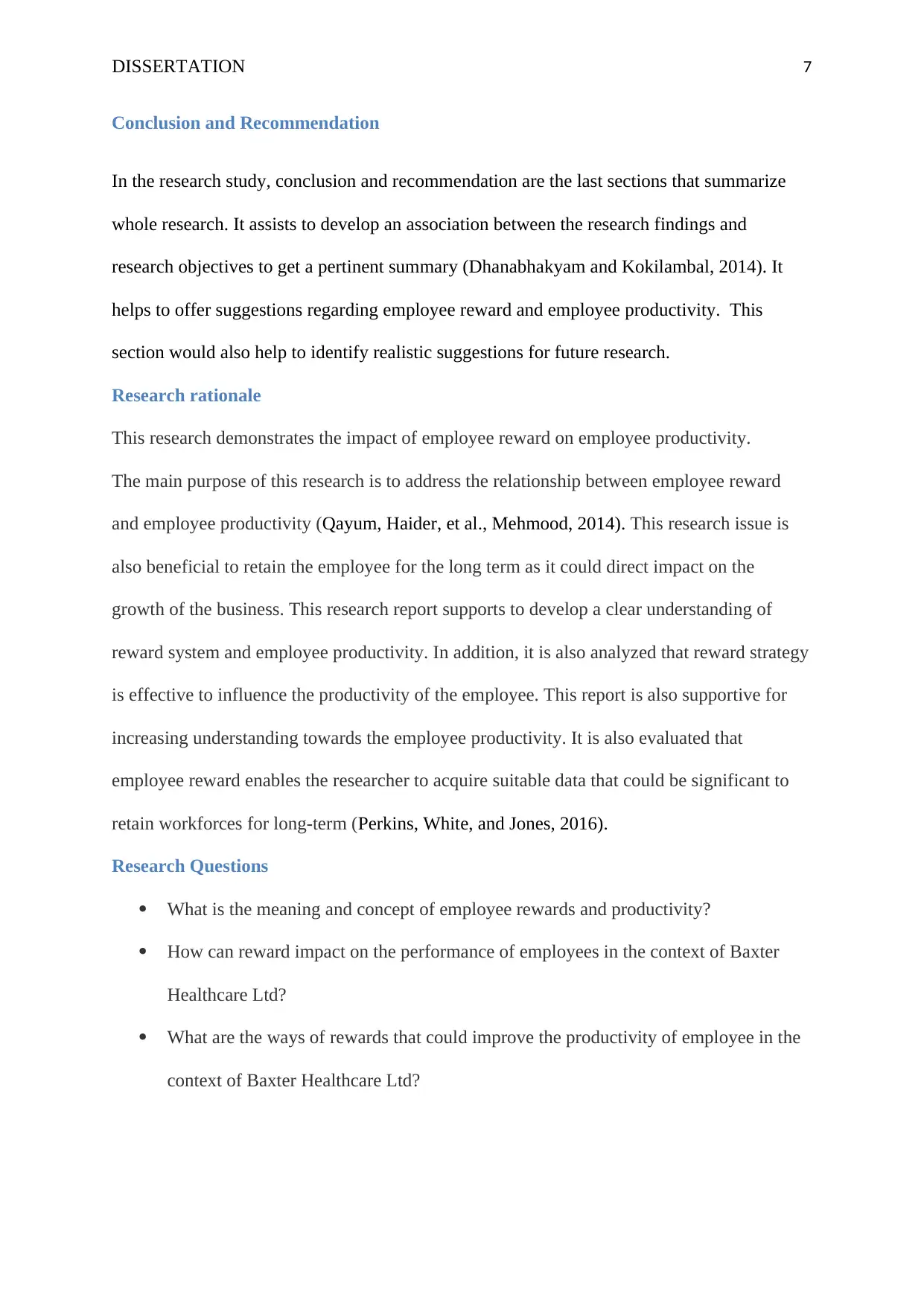
DISSERTATION 7
Conclusion and Recommendation
In the research study, conclusion and recommendation are the last sections that summarize
whole research. It assists to develop an association between the research findings and
research objectives to get a pertinent summary (Dhanabhakyam and Kokilambal, 2014). It
helps to offer suggestions regarding employee reward and employee productivity. This
section would also help to identify realistic suggestions for future research.
Research rationale
This research demonstrates the impact of employee reward on employee productivity.
The main purpose of this research is to address the relationship between employee reward
and employee productivity (Qayum, Haider, et al., Mehmood, 2014). This research issue is
also beneficial to retain the employee for the long term as it could direct impact on the
growth of the business. This research report supports to develop a clear understanding of
reward system and employee productivity. In addition, it is also analyzed that reward strategy
is effective to influence the productivity of the employee. This report is also supportive for
increasing understanding towards the employee productivity. It is also evaluated that
employee reward enables the researcher to acquire suitable data that could be significant to
retain workforces for long-term (Perkins, White, and Jones, 2016).
Research Questions
What is the meaning and concept of employee rewards and productivity?
How can reward impact on the performance of employees in the context of Baxter
Healthcare Ltd?
What are the ways of rewards that could improve the productivity of employee in the
context of Baxter Healthcare Ltd?
Conclusion and Recommendation
In the research study, conclusion and recommendation are the last sections that summarize
whole research. It assists to develop an association between the research findings and
research objectives to get a pertinent summary (Dhanabhakyam and Kokilambal, 2014). It
helps to offer suggestions regarding employee reward and employee productivity. This
section would also help to identify realistic suggestions for future research.
Research rationale
This research demonstrates the impact of employee reward on employee productivity.
The main purpose of this research is to address the relationship between employee reward
and employee productivity (Qayum, Haider, et al., Mehmood, 2014). This research issue is
also beneficial to retain the employee for the long term as it could direct impact on the
growth of the business. This research report supports to develop a clear understanding of
reward system and employee productivity. In addition, it is also analyzed that reward strategy
is effective to influence the productivity of the employee. This report is also supportive for
increasing understanding towards the employee productivity. It is also evaluated that
employee reward enables the researcher to acquire suitable data that could be significant to
retain workforces for long-term (Perkins, White, and Jones, 2016).
Research Questions
What is the meaning and concept of employee rewards and productivity?
How can reward impact on the performance of employees in the context of Baxter
Healthcare Ltd?
What are the ways of rewards that could improve the productivity of employee in the
context of Baxter Healthcare Ltd?
Paraphrase This Document
Need a fresh take? Get an instant paraphrase of this document with our AI Paraphraser
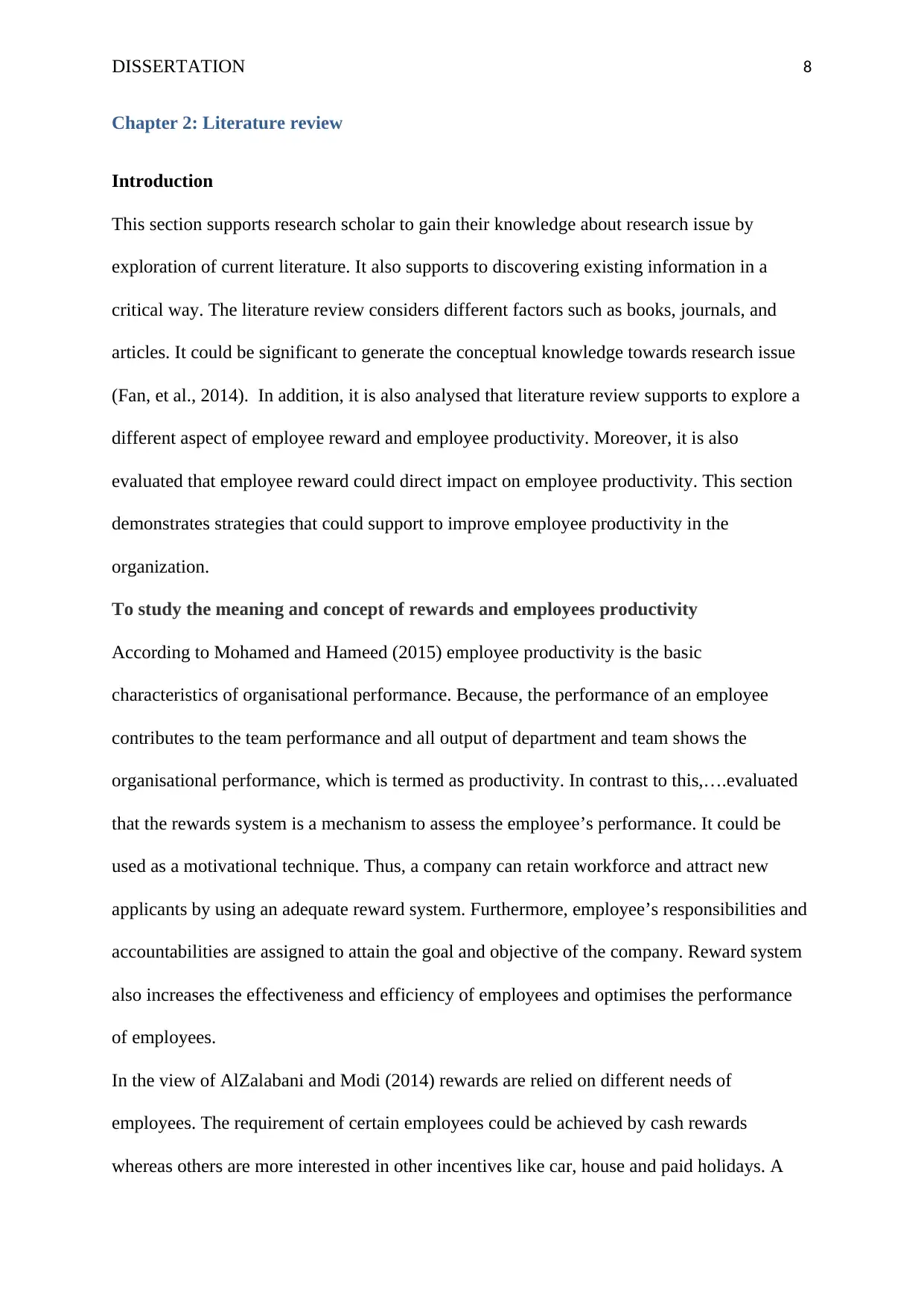
DISSERTATION 8
Chapter 2: Literature review
Introduction
This section supports research scholar to gain their knowledge about research issue by
exploration of current literature. It also supports to discovering existing information in a
critical way. The literature review considers different factors such as books, journals, and
articles. It could be significant to generate the conceptual knowledge towards research issue
(Fan, et al., 2014). In addition, it is also analysed that literature review supports to explore a
different aspect of employee reward and employee productivity. Moreover, it is also
evaluated that employee reward could direct impact on employee productivity. This section
demonstrates strategies that could support to improve employee productivity in the
organization.
To study the meaning and concept of rewards and employees productivity
According to Mohamed and Hameed (2015) employee productivity is the basic
characteristics of organisational performance. Because, the performance of an employee
contributes to the team performance and all output of department and team shows the
organisational performance, which is termed as productivity. In contrast to this,….evaluated
that the rewards system is a mechanism to assess the employee’s performance. It could be
used as a motivational technique. Thus, a company can retain workforce and attract new
applicants by using an adequate reward system. Furthermore, employee’s responsibilities and
accountabilities are assigned to attain the goal and objective of the company. Reward system
also increases the effectiveness and efficiency of employees and optimises the performance
of employees.
In the view of AlZalabani and Modi (2014) rewards are relied on different needs of
employees. The requirement of certain employees could be achieved by cash rewards
whereas others are more interested in other incentives like car, house and paid holidays. A
Chapter 2: Literature review
Introduction
This section supports research scholar to gain their knowledge about research issue by
exploration of current literature. It also supports to discovering existing information in a
critical way. The literature review considers different factors such as books, journals, and
articles. It could be significant to generate the conceptual knowledge towards research issue
(Fan, et al., 2014). In addition, it is also analysed that literature review supports to explore a
different aspect of employee reward and employee productivity. Moreover, it is also
evaluated that employee reward could direct impact on employee productivity. This section
demonstrates strategies that could support to improve employee productivity in the
organization.
To study the meaning and concept of rewards and employees productivity
According to Mohamed and Hameed (2015) employee productivity is the basic
characteristics of organisational performance. Because, the performance of an employee
contributes to the team performance and all output of department and team shows the
organisational performance, which is termed as productivity. In contrast to this,….evaluated
that the rewards system is a mechanism to assess the employee’s performance. It could be
used as a motivational technique. Thus, a company can retain workforce and attract new
applicants by using an adequate reward system. Furthermore, employee’s responsibilities and
accountabilities are assigned to attain the goal and objective of the company. Reward system
also increases the effectiveness and efficiency of employees and optimises the performance
of employees.
In the view of AlZalabani and Modi (2014) rewards are relied on different needs of
employees. The requirement of certain employees could be achieved by cash rewards
whereas others are more interested in other incentives like car, house and paid holidays. A
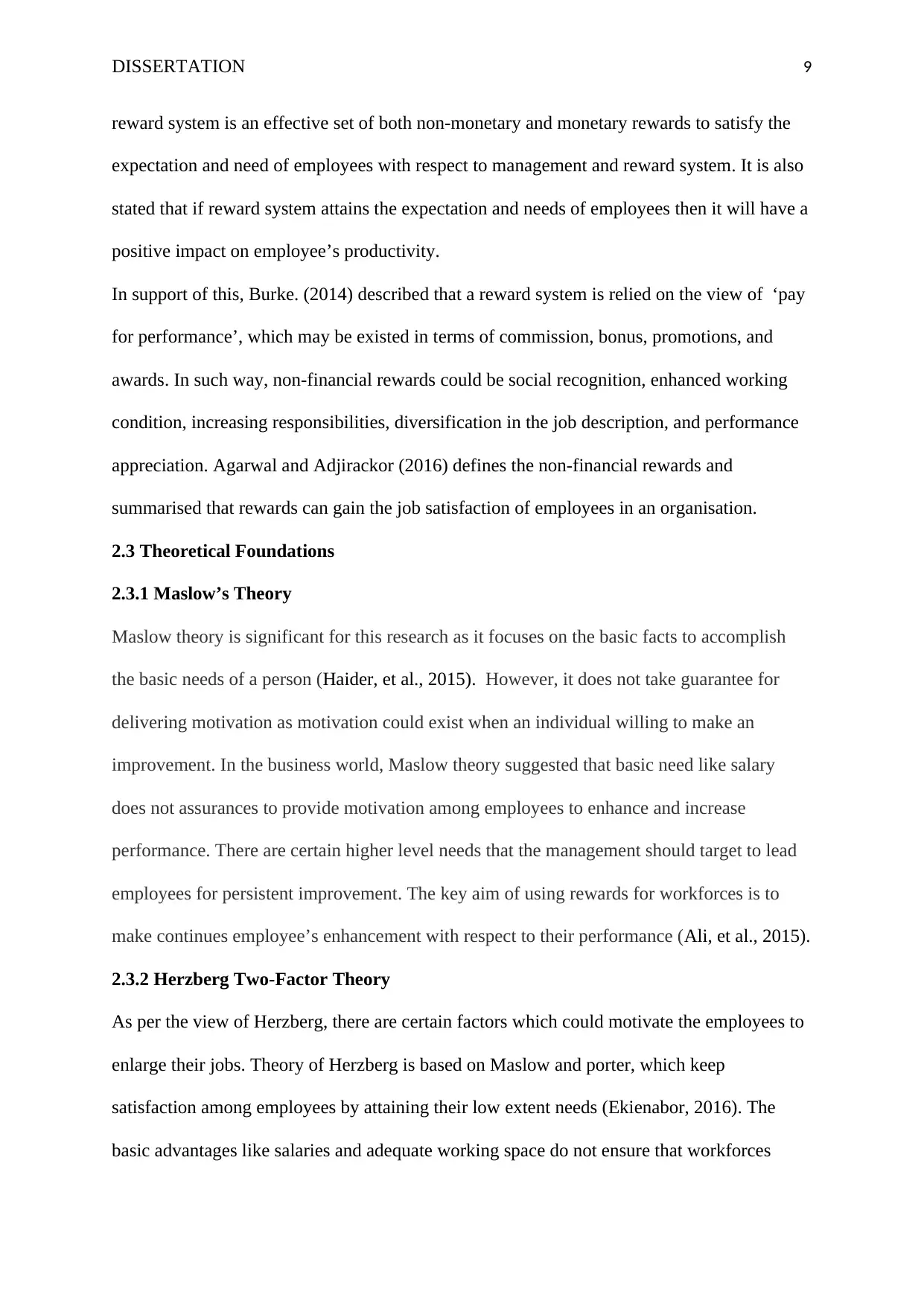
DISSERTATION 9
reward system is an effective set of both non-monetary and monetary rewards to satisfy the
expectation and need of employees with respect to management and reward system. It is also
stated that if reward system attains the expectation and needs of employees then it will have a
positive impact on employee’s productivity.
In support of this, Burke. (2014) described that a reward system is relied on the view of ‘pay
for performance’, which may be existed in terms of commission, bonus, promotions, and
awards. In such way, non-financial rewards could be social recognition, enhanced working
condition, increasing responsibilities, diversification in the job description, and performance
appreciation. Agarwal and Adjirackor (2016) defines the non-financial rewards and
summarised that rewards can gain the job satisfaction of employees in an organisation.
2.3 Theoretical Foundations
2.3.1 Maslow’s Theory
Maslow theory is significant for this research as it focuses on the basic facts to accomplish
the basic needs of a person (Haider, et al., 2015). However, it does not take guarantee for
delivering motivation as motivation could exist when an individual willing to make an
improvement. In the business world, Maslow theory suggested that basic need like salary
does not assurances to provide motivation among employees to enhance and increase
performance. There are certain higher level needs that the management should target to lead
employees for persistent improvement. The key aim of using rewards for workforces is to
make continues employee’s enhancement with respect to their performance (Ali, et al., 2015).
2.3.2 Herzberg Two-Factor Theory
As per the view of Herzberg, there are certain factors which could motivate the employees to
enlarge their jobs. Theory of Herzberg is based on Maslow and porter, which keep
satisfaction among employees by attaining their low extent needs (Ekienabor, 2016). The
basic advantages like salaries and adequate working space do not ensure that workforces
reward system is an effective set of both non-monetary and monetary rewards to satisfy the
expectation and need of employees with respect to management and reward system. It is also
stated that if reward system attains the expectation and needs of employees then it will have a
positive impact on employee’s productivity.
In support of this, Burke. (2014) described that a reward system is relied on the view of ‘pay
for performance’, which may be existed in terms of commission, bonus, promotions, and
awards. In such way, non-financial rewards could be social recognition, enhanced working
condition, increasing responsibilities, diversification in the job description, and performance
appreciation. Agarwal and Adjirackor (2016) defines the non-financial rewards and
summarised that rewards can gain the job satisfaction of employees in an organisation.
2.3 Theoretical Foundations
2.3.1 Maslow’s Theory
Maslow theory is significant for this research as it focuses on the basic facts to accomplish
the basic needs of a person (Haider, et al., 2015). However, it does not take guarantee for
delivering motivation as motivation could exist when an individual willing to make an
improvement. In the business world, Maslow theory suggested that basic need like salary
does not assurances to provide motivation among employees to enhance and increase
performance. There are certain higher level needs that the management should target to lead
employees for persistent improvement. The key aim of using rewards for workforces is to
make continues employee’s enhancement with respect to their performance (Ali, et al., 2015).
2.3.2 Herzberg Two-Factor Theory
As per the view of Herzberg, there are certain factors which could motivate the employees to
enlarge their jobs. Theory of Herzberg is based on Maslow and porter, which keep
satisfaction among employees by attaining their low extent needs (Ekienabor, 2016). The
basic advantages like salaries and adequate working space do not ensure that workforces
⊘ This is a preview!⊘
Do you want full access?
Subscribe today to unlock all pages.

Trusted by 1+ million students worldwide
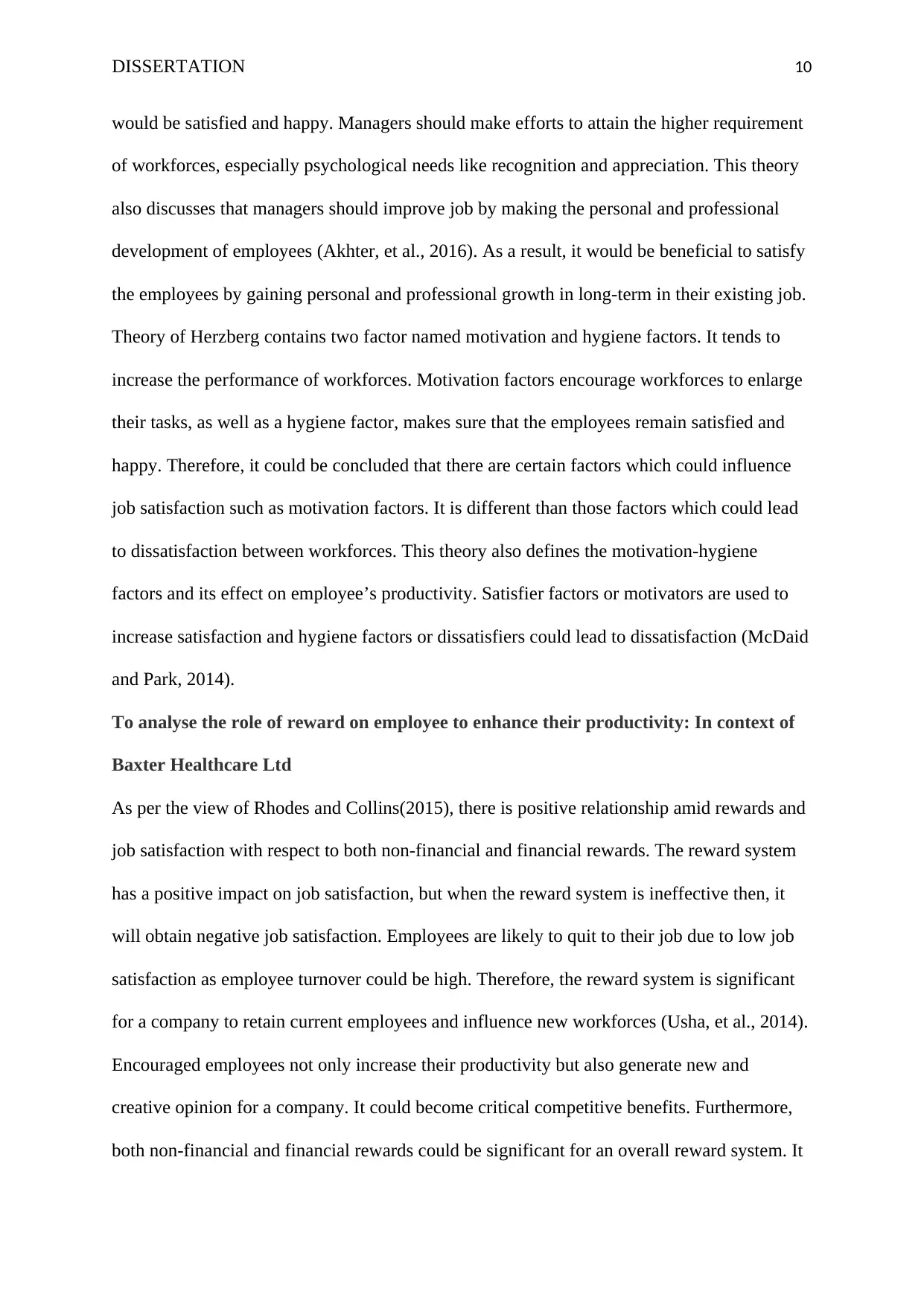
DISSERTATION 10
would be satisfied and happy. Managers should make efforts to attain the higher requirement
of workforces, especially psychological needs like recognition and appreciation. This theory
also discusses that managers should improve job by making the personal and professional
development of employees (Akhter, et al., 2016). As a result, it would be beneficial to satisfy
the employees by gaining personal and professional growth in long-term in their existing job.
Theory of Herzberg contains two factor named motivation and hygiene factors. It tends to
increase the performance of workforces. Motivation factors encourage workforces to enlarge
their tasks, as well as a hygiene factor, makes sure that the employees remain satisfied and
happy. Therefore, it could be concluded that there are certain factors which could influence
job satisfaction such as motivation factors. It is different than those factors which could lead
to dissatisfaction between workforces. This theory also defines the motivation-hygiene
factors and its effect on employee’s productivity. Satisfier factors or motivators are used to
increase satisfaction and hygiene factors or dissatisfiers could lead to dissatisfaction (McDaid
and Park, 2014).
To analyse the role of reward on employee to enhance their productivity: In context of
Baxter Healthcare Ltd
As per the view of Rhodes and Collins(2015), there is positive relationship amid rewards and
job satisfaction with respect to both non-financial and financial rewards. The reward system
has a positive impact on job satisfaction, but when the reward system is ineffective then, it
will obtain negative job satisfaction. Employees are likely to quit to their job due to low job
satisfaction as employee turnover could be high. Therefore, the reward system is significant
for a company to retain current employees and influence new workforces (Usha, et al., 2014).
Encouraged employees not only increase their productivity but also generate new and
creative opinion for a company. It could become critical competitive benefits. Furthermore,
both non-financial and financial rewards could be significant for an overall reward system. It
would be satisfied and happy. Managers should make efforts to attain the higher requirement
of workforces, especially psychological needs like recognition and appreciation. This theory
also discusses that managers should improve job by making the personal and professional
development of employees (Akhter, et al., 2016). As a result, it would be beneficial to satisfy
the employees by gaining personal and professional growth in long-term in their existing job.
Theory of Herzberg contains two factor named motivation and hygiene factors. It tends to
increase the performance of workforces. Motivation factors encourage workforces to enlarge
their tasks, as well as a hygiene factor, makes sure that the employees remain satisfied and
happy. Therefore, it could be concluded that there are certain factors which could influence
job satisfaction such as motivation factors. It is different than those factors which could lead
to dissatisfaction between workforces. This theory also defines the motivation-hygiene
factors and its effect on employee’s productivity. Satisfier factors or motivators are used to
increase satisfaction and hygiene factors or dissatisfiers could lead to dissatisfaction (McDaid
and Park, 2014).
To analyse the role of reward on employee to enhance their productivity: In context of
Baxter Healthcare Ltd
As per the view of Rhodes and Collins(2015), there is positive relationship amid rewards and
job satisfaction with respect to both non-financial and financial rewards. The reward system
has a positive impact on job satisfaction, but when the reward system is ineffective then, it
will obtain negative job satisfaction. Employees are likely to quit to their job due to low job
satisfaction as employee turnover could be high. Therefore, the reward system is significant
for a company to retain current employees and influence new workforces (Usha, et al., 2014).
Encouraged employees not only increase their productivity but also generate new and
creative opinion for a company. It could become critical competitive benefits. Furthermore,
both non-financial and financial rewards could be significant for an overall reward system. It
Paraphrase This Document
Need a fresh take? Get an instant paraphrase of this document with our AI Paraphraser
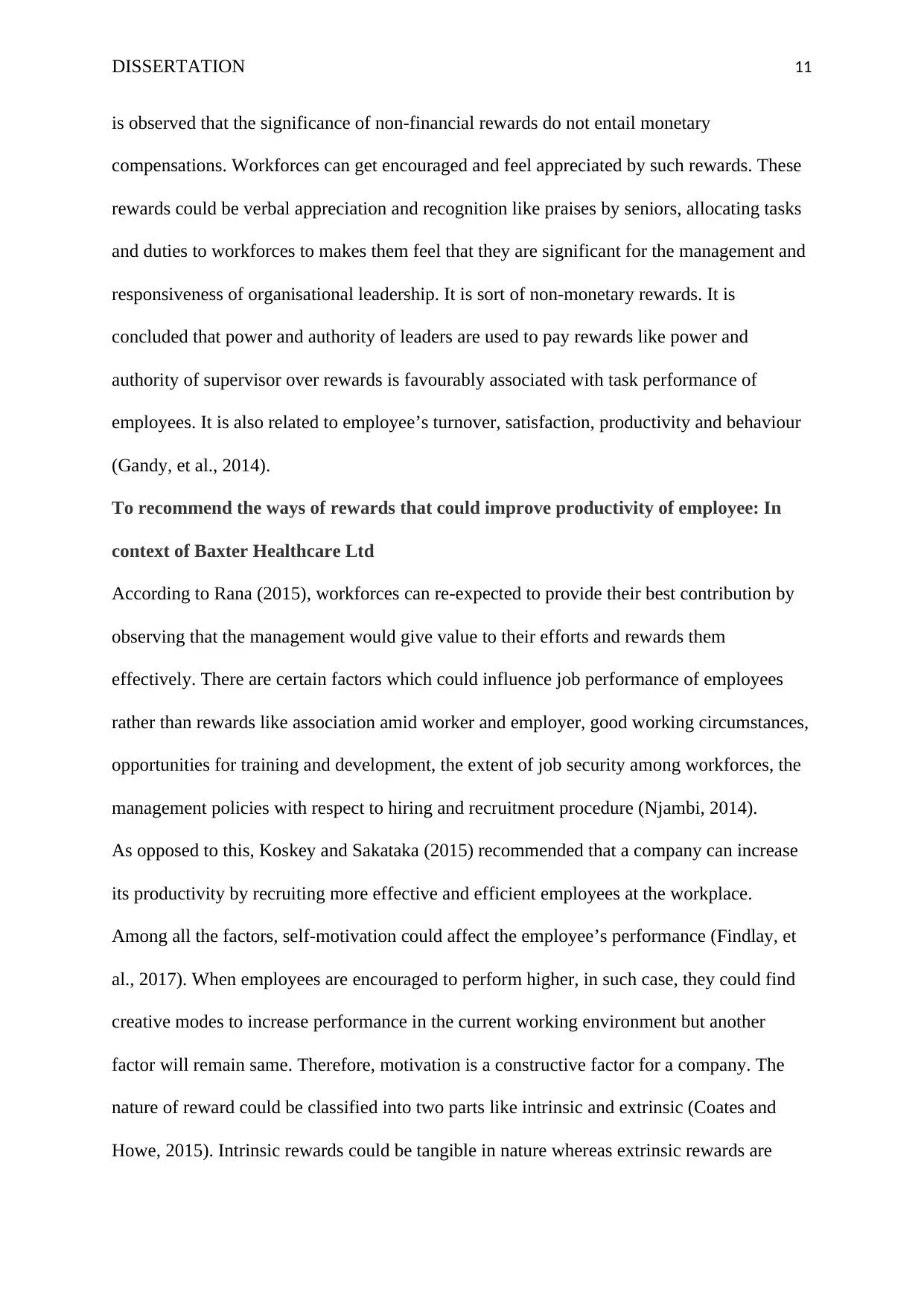
DISSERTATION 11
is observed that the significance of non-financial rewards do not entail monetary
compensations. Workforces can get encouraged and feel appreciated by such rewards. These
rewards could be verbal appreciation and recognition like praises by seniors, allocating tasks
and duties to workforces to makes them feel that they are significant for the management and
responsiveness of organisational leadership. It is sort of non-monetary rewards. It is
concluded that power and authority of leaders are used to pay rewards like power and
authority of supervisor over rewards is favourably associated with task performance of
employees. It is also related to employee’s turnover, satisfaction, productivity and behaviour
(Gandy, et al., 2014).
To recommend the ways of rewards that could improve productivity of employee: In
context of Baxter Healthcare Ltd
According to Rana (2015), workforces can re-expected to provide their best contribution by
observing that the management would give value to their efforts and rewards them
effectively. There are certain factors which could influence job performance of employees
rather than rewards like association amid worker and employer, good working circumstances,
opportunities for training and development, the extent of job security among workforces, the
management policies with respect to hiring and recruitment procedure (Njambi, 2014).
As opposed to this, Koskey and Sakataka (2015) recommended that a company can increase
its productivity by recruiting more effective and efficient employees at the workplace.
Among all the factors, self-motivation could affect the employee’s performance (Findlay, et
al., 2017). When employees are encouraged to perform higher, in such case, they could find
creative modes to increase performance in the current working environment but another
factor will remain same. Therefore, motivation is a constructive factor for a company. The
nature of reward could be classified into two parts like intrinsic and extrinsic (Coates and
Howe, 2015). Intrinsic rewards could be tangible in nature whereas extrinsic rewards are
is observed that the significance of non-financial rewards do not entail monetary
compensations. Workforces can get encouraged and feel appreciated by such rewards. These
rewards could be verbal appreciation and recognition like praises by seniors, allocating tasks
and duties to workforces to makes them feel that they are significant for the management and
responsiveness of organisational leadership. It is sort of non-monetary rewards. It is
concluded that power and authority of leaders are used to pay rewards like power and
authority of supervisor over rewards is favourably associated with task performance of
employees. It is also related to employee’s turnover, satisfaction, productivity and behaviour
(Gandy, et al., 2014).
To recommend the ways of rewards that could improve productivity of employee: In
context of Baxter Healthcare Ltd
According to Rana (2015), workforces can re-expected to provide their best contribution by
observing that the management would give value to their efforts and rewards them
effectively. There are certain factors which could influence job performance of employees
rather than rewards like association amid worker and employer, good working circumstances,
opportunities for training and development, the extent of job security among workforces, the
management policies with respect to hiring and recruitment procedure (Njambi, 2014).
As opposed to this, Koskey and Sakataka (2015) recommended that a company can increase
its productivity by recruiting more effective and efficient employees at the workplace.
Among all the factors, self-motivation could affect the employee’s performance (Findlay, et
al., 2017). When employees are encouraged to perform higher, in such case, they could find
creative modes to increase performance in the current working environment but another
factor will remain same. Therefore, motivation is a constructive factor for a company. The
nature of reward could be classified into two parts like intrinsic and extrinsic (Coates and
Howe, 2015). Intrinsic rewards could be tangible in nature whereas extrinsic rewards are
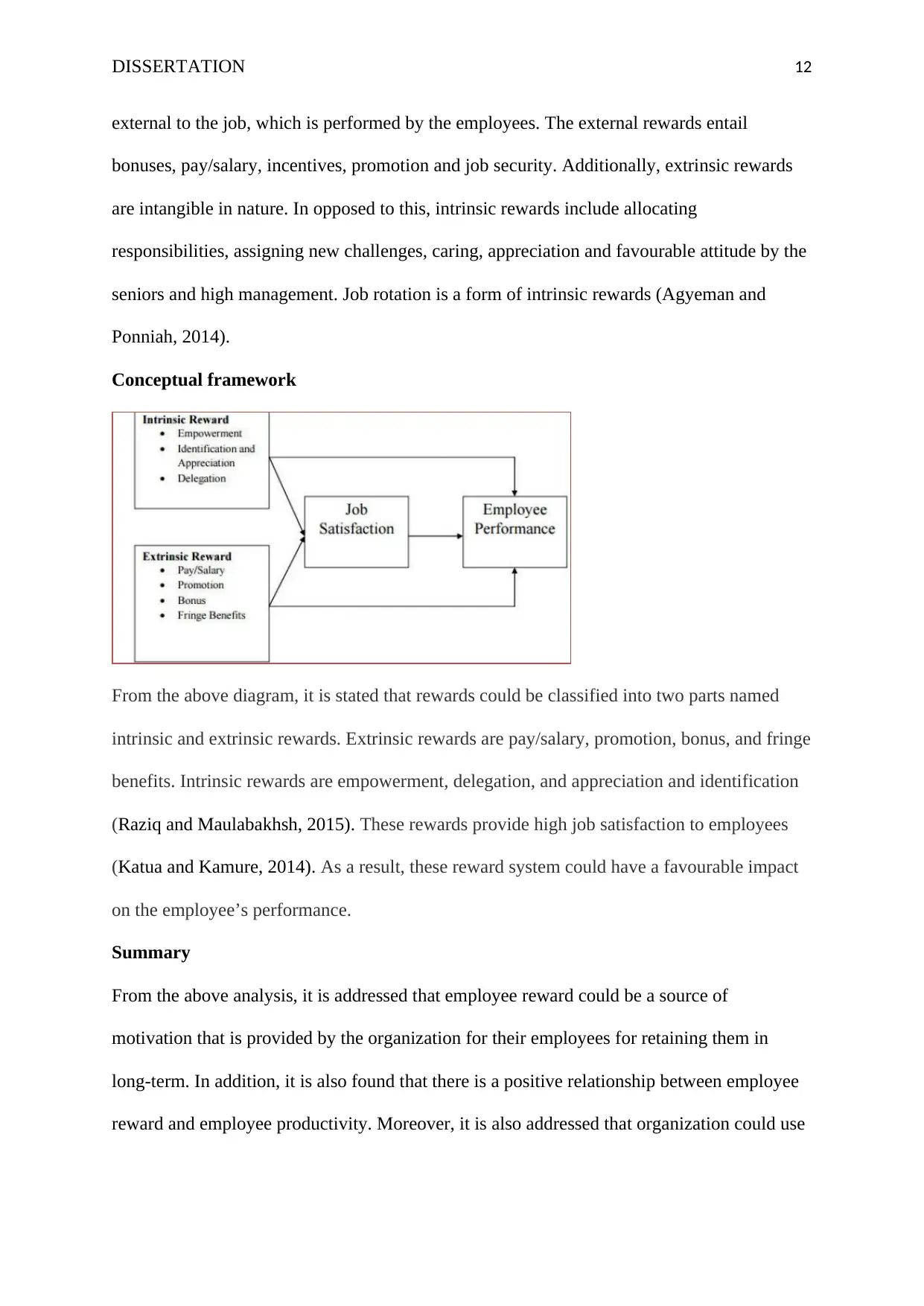
DISSERTATION 12
external to the job, which is performed by the employees. The external rewards entail
bonuses, pay/salary, incentives, promotion and job security. Additionally, extrinsic rewards
are intangible in nature. In opposed to this, intrinsic rewards include allocating
responsibilities, assigning new challenges, caring, appreciation and favourable attitude by the
seniors and high management. Job rotation is a form of intrinsic rewards (Agyeman and
Ponniah, 2014).
Conceptual framework
From the above diagram, it is stated that rewards could be classified into two parts named
intrinsic and extrinsic rewards. Extrinsic rewards are pay/salary, promotion, bonus, and fringe
benefits. Intrinsic rewards are empowerment, delegation, and appreciation and identification
(Raziq and Maulabakhsh, 2015). These rewards provide high job satisfaction to employees
(Katua and Kamure, 2014). As a result, these reward system could have a favourable impact
on the employee’s performance.
Summary
From the above analysis, it is addressed that employee reward could be a source of
motivation that is provided by the organization for their employees for retaining them in
long-term. In addition, it is also found that there is a positive relationship between employee
reward and employee productivity. Moreover, it is also addressed that organization could use
external to the job, which is performed by the employees. The external rewards entail
bonuses, pay/salary, incentives, promotion and job security. Additionally, extrinsic rewards
are intangible in nature. In opposed to this, intrinsic rewards include allocating
responsibilities, assigning new challenges, caring, appreciation and favourable attitude by the
seniors and high management. Job rotation is a form of intrinsic rewards (Agyeman and
Ponniah, 2014).
Conceptual framework
From the above diagram, it is stated that rewards could be classified into two parts named
intrinsic and extrinsic rewards. Extrinsic rewards are pay/salary, promotion, bonus, and fringe
benefits. Intrinsic rewards are empowerment, delegation, and appreciation and identification
(Raziq and Maulabakhsh, 2015). These rewards provide high job satisfaction to employees
(Katua and Kamure, 2014). As a result, these reward system could have a favourable impact
on the employee’s performance.
Summary
From the above analysis, it is addressed that employee reward could be a source of
motivation that is provided by the organization for their employees for retaining them in
long-term. In addition, it is also found that there is a positive relationship between employee
reward and employee productivity. Moreover, it is also addressed that organization could use
⊘ This is a preview!⊘
Do you want full access?
Subscribe today to unlock all pages.

Trusted by 1+ million students worldwide
1 out of 54
Related Documents
Your All-in-One AI-Powered Toolkit for Academic Success.
+13062052269
info@desklib.com
Available 24*7 on WhatsApp / Email
![[object Object]](/_next/static/media/star-bottom.7253800d.svg)
Unlock your academic potential
Copyright © 2020–2025 A2Z Services. All Rights Reserved. Developed and managed by ZUCOL.





